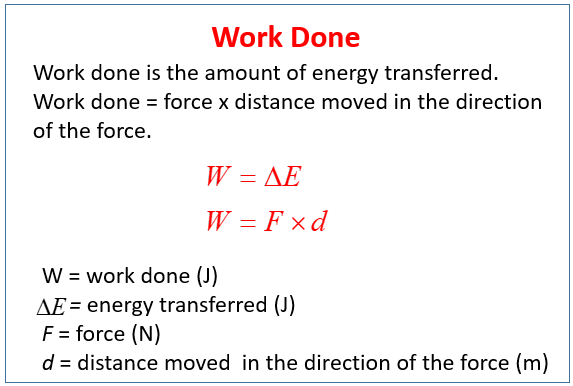Work Done by a Force
Related Pages
Work Done & Energy Transfer
Power & Work Done
More Lessons for IGCSE Physics
A series of free GCSE/IGCSE Physics Notes and Lessons.
In these lessons, we will learn to
- describe what is meant by work done.
- calculate work done by a force acting on a force.
Work Done by a Force
In physics, Work Done by a Force is a measure of the energy transferred to or from an object when a force causes a displacement of that object. It’s not just about applying a force; the object must move as a result of that force, and there must be a component of the force in the direction of the movement.
The following diagram gives the formula for work done by a force. Scroll down the page for more examples and solutions on how to use the formula.

Explanation of the Components:
-
Force (F):
This is the push or pull acting on the object. It’s a vector quantity, meaning it has both magnitude and direction.
Only the component of the force that is parallel to the displacement contributes to doing work. -
Displacement (d):
This is the change in the object’s position. It’s also a vector quantity, with magnitude (distance moved) and direction.
For work to be done, there must be a displacement. If you push on a wall all day but it doesn’t move, no work is done by your force on the wall.
Video
Work is done whenever energy is transferred from one store to another.
Mechanical work involves using a force to move an object.
Electrical work involves a current transferring energy.
Work done (J) = Force (N) x Distance (m)
Example:
During braking, a force of 2000N is applied to the brakes of a car. The car takes 20m to come
to a stop. Calculate the work done.
Work Done By a Constant Force & Energy Transfer
Example 1:
A man applies a force of 700 N to a crate and pushes it through a distance of 200 cm. Calculate the amount of work done by the man.
Example 2:
Another man pushes a crate as shown with a force of 550 N and soes 2.2 kJ of work.
a) Through what distance does he push the crate?
b) The box does not speed up or slow down during this time. What happens to the energy transferred by the man?
Example 3:
A car drives 10 m up a hill at constant speed, as shown, If its weight is 15 kN and there is a frictional force of 4 kN acting between its tyres and the road surface, calculate:
a) the amount of work it does against fiction.
b) the amount of work it does against gravity.
Work Done By a Constant Force & By Friction, Net Work Calculations
How to calculate the work done by a constant force and how to calculate the work done by friction?
How to calculate the net work done on an object?
Whenever the force and displacement vector are parallel to each other, the work done on an object is positive which causes the speed and kinetic energy of the object to increase. If the force and displacement vectors are perpendicular, no work is done and the object’s kinetic energy remains constant. The work done by friction is usually negative since the kinetic friction force vector is antiparallel to an object’s displacement.
Examples:
-
(a) How much work is done by a horizontal force of 150N that acts on a crate for a distance of 10m?
(b)How much work is done on the crate across the frictionless surface?
(c) How much work is done on the crate if the crate returns to rest due to friction. -
A 40kg box is pulled 100m by a tension force of 200N at 30 degrees above the horizontal to the right. A constant kinetic frictional force of 80N impedes the motion of the box.
(a) What is the work done by the tension force?
(b) How much work is done by friction?
(c) Calculate the net work done on the box.
Try out our new and fun Fraction Concoction Game.
Add and subtract fractions to make exciting fraction concoctions following a recipe. There are four levels of difficulty: Easy, medium, hard and insane. Practice the basics of fraction addition and subtraction or challenge yourself with the insane level.

We welcome your feedback, comments and questions about this site or page. Please submit your feedback or enquiries via our Feedback page.